Order Artiodactyla Scientific name Gazella cuvieri Rank Species | Phylum Chordata Genus Gazella Higher classification Gazelle | |
 | ||
Similar Gazelle, Rhim gazelle, Dorcas gazelle, Red‑fronted gazelle, Jentink's duiker | ||
Cuvier s gazelle
Cuvier's gazelle (Gazella cuvieri) is a species of gazelle found in Algeria, Morocco and Tunisia. It is also known as the edmi. It is one of the darkest species of gazelle in coloring, due to its partial woodland habitat. It is sometimes placed in a separate genus, Trachelocele, from other gazelles, together with goitered gazelles and rhim gazelles. It is very rare in the wild with only 2000 individuals.
Contents
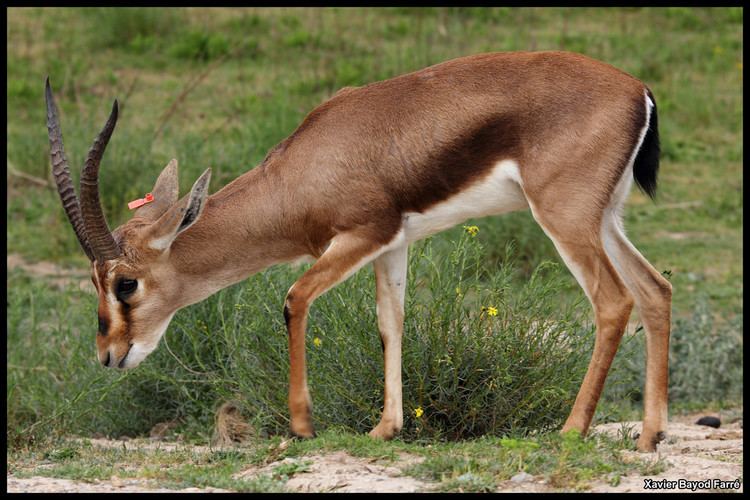
Characteristics

The Cuvier’s gazelle is one of the darkest and smallest of the gazelle species, standing 60–69 cm (1.97–2.26 ft) tall, with an average weight of 35 kg (77 lb). It is characterized by a distinctive wide, dark band that runs along the sides of the animal, which separates the brown dorsal parts from the white ventral parts. While both sexes have horns between 10 and 15 cm (3.9 and 5.9 in) long, the males' are more ribbed and have greater mass. Also they possess long, slender ears.
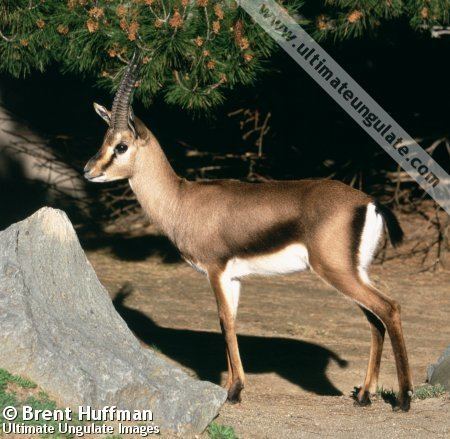
The purpose of the dark bands that run parallel along the side of the animal is to aid in countershading, having ventral body pelage that is more lightly colored that the dorsal surface. This may reduce the shadows produced by the animal’s body. The sun shining downward on the animal will cause an unequal distribution of light, disrupting the pattern created by its silhouette. The darker colors compared to other gazelles could be explained by its shadier habitats.
Status
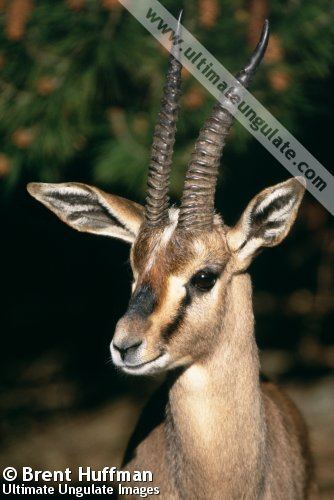
In the past, the reason for decline of the gazelle was overhunting for skins, meat, and trophies. In the 1930s, it was already considered one of the rarest gazelles, but it was not listed as endangered until the 1960s. Though it is now unlawful to hunt this animal, they still suffer from habitat stress due to local farmers destroying habitat for pastureland and competition from domestic sheep and goats.
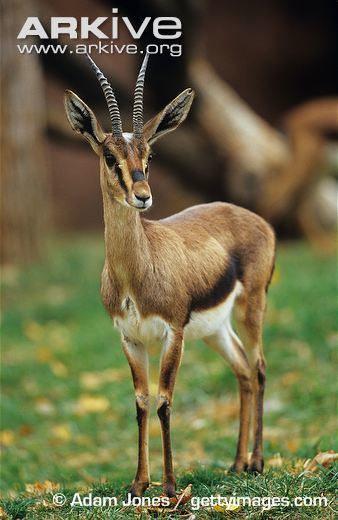
Once thought to be extinct in the wild, the gazelle’s population is now thought to be less than 2000, occupying small pockets of the Atlas Mountains. Many of the animals can be found on protected land in Tunisia, but this is not the case in Morocco and Algeria, where many of the animals are still being outcompeted for food from livestock. One of the most important refuges is Djebel Chambi National Park, which holds the largest population in Tunisia. In Algeria the 200,000 ha Saharan Atlas National Park is a refuge for about hundred Cuvier's gazelles. The Belezma National Park has about 20, but this figure is uncertain and a reintroduction has been planned.
Habitat
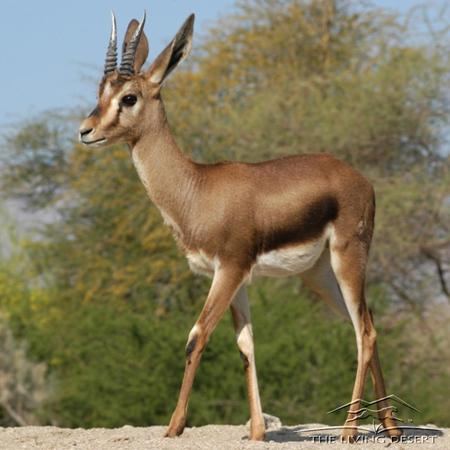
Cuvier’s gazelle inhabits the Atlas Mountains in Northwestern Africa. It is found in many different types of landscapes. The preference is for sandy or stony hills and plateaus. Also they occupy areas of regenerating forests and lush pine forests. During the early parts of the morning and late parts of the evening they come out of the mountains to graze in the low grasslands. Then in the afternoon they will travel back up the mountain into the forests and find a cool place to spend the day.
Behavior
Cuvier’s gazelle tend to live in social groups of three or four during mating season, but usually not more than eight. Groups tend to contain one male and up to three females each with up to two offspring. During the mating season, the dominant males will force the younger males out of the social group; they will form bachelor groups. Then, the females will leave the group to give birth. After giving birth, females will join bachelor groups and live the rest of mating season with them.
Their main defense is their alertness. When sensing something suspicious, they will set off an alert signal by flicking their tails and performing a strong gait, of jumping into the air and having all four hooves land on the ground at the same time. Along with their alertness, they are also one of the fastest gazelles, reaching and sustaining top speeds over 50 mph.
Reproduction
With the gestation period lasting around 160 days, the gazelles tend to breed in the winter and give birth in the early spring. Before giving birth, the mother will separate herself from the herd to give birth, and then hide the newborn in the thick underbrush outside the herd, returning occasionally to nurse it. This occurs for the first month until the newborn begins to eat vegetation, but still relying on nourishment from its mother.
The Cuvier’s gazelle is one of the few gazelle species to frequently give birth to twins (40.5%), with singlets weighing an average of 2.99 kg (6.59 lb) and twins weighing an average of 2.85 kg (6.28 lb). Ten days after giving birth, the females may breed again, giving birth to two sets of offspring per year. Newborn females can become fertile as early as 27 weeks and can give birth as soon as 70 weeks of age.
As herbivorous ruminants, the diet of a Cuvier’s gazelle entirely contains leaves, grasses, and other vegetation. They will consume large amounts of greenery and find a cool place during the day to finish chewing their cuds, remnant wads of food that return from the stomach (eructation) to be chewed a second time for further digestion.
